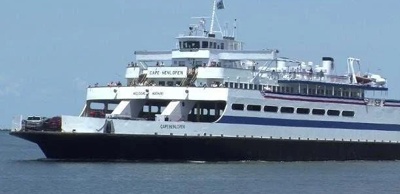There was actually a brief period of time in the late nineteenth century that a smaller ferry service operated between the Capes of Henlopen and May. It was operated by the Queen Anne's Railroad. The rail part of the journey would cross the Delmarva peninsula with stops in between, before ending in Lewes. A side-wheeled ferry, The Virginia would take passengers across the bay to Cape May. That ferry connection ended in 1904 when the railroad filed for bankruptcy.
The first half of the twentieth century saw several attempts at another ferry fail to get beyond the planning stage. On February 6, 1963 the Delaware River and Bay Authority (DRBA) was organized and voted to launch a feasibility study of establishing the Cape May-Lewes Ferry. At a cost of $7,040,370.10 the ferry was ready by the end of June 1964.
While Lippi is the first paying customer in history, the first trip with passengers on the ferry occurred the day before on June 30, 1964. A dedication ceremony was held in Lewes. The Lewes High School Band played the National Anthem and remarks were given by Delaware Governor Elbert Carvel (D) and New Jersey Governor Richard Hughes (D). Then the dignitaries rode on the ferry to New Jersey were a similar ceremony was held at the site of the Cape May terminal.
As traffic increased in the 1970s and with New Jersey about to make gambling legal in the state, a move to construct a bridge-tunnel linking the southern parts of Delaware and New Jersey had some momentum. According to a May 4, 1977 report in the Press of Atlantic City, the Rehoboth Beach Chamber of Commerce backed a feasibility study for a bridge-tunnel that would be built on land near Milford and connect on the east side of the bay in Cape May County. It would have been the second longest bridge in the U.S. The study concluded that a bridge-tunnel would cost $200-$250 million. The chairman of the DRBA at the time Clarence McCormick told the New York Times, "I's a waste of time unless the Federal Government wants to put up the half‐billion dollars it will take, and that I doubt very much.”
When the ferry first launched, its schedule was nearly around the clock. The demand for the early and late times was not enough to keep the ships staffed and running. Now the first ship departs Lewes at 8:45 a.m. with the final departure at 7:45 p.m.
The DRBA is looking towards the near-future by bringing a hybrid powered ferry to the fleet. "It'll run some time on batteries and some time on diesel engines, which will be much cleaner than the technology we're employing today," Director of Ferry Operations Heath Gehrke told CoastTV. "As we get additional charging capacity and additional charging infrastructure, we're hoping that will be 100 percent green."
For the sixtieth anniversary week, the DRBA is planning some promotions including signature drinks and a commemorative ticket.







